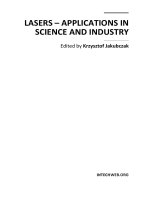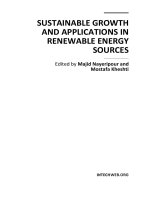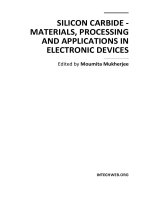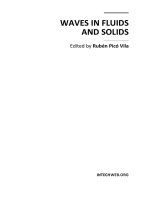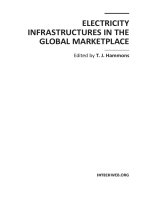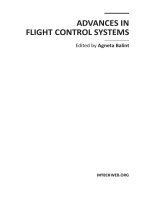Rapid Learning in Robotics - Jorg Walter Part 1 docx
Bạn đang xem bản rút gọn của tài liệu. Xem và tải ngay bản đầy đủ của tài liệu tại đây (95.04 KB, 16 trang )
J rg Walter
Jörg Walter
Die Deutsche Bibliothek — CIP Data
Walter, Jörg
Rapid Learning in Robotics / by Jörg Walter, 1st ed.
Göttingen: Cuvillier, 1996
Zugl.: Bielefeld, Univ., Diss. 1996
ISBN 3-89588-728-5
Copyright:
c
1997, 1996 for electronic publishing: Jörg Walter
Technische Fakultät, Universität Bielefeld, AG Neuroinformatik
PBox 100131, 33615 Bielefeld, Germany
Email:
Url: />walter/
c
1997 for hard copy publishing: Cuvillier Verlag
Nonnenstieg 8, D-37075 Göttingen, Germany, Fax: +49-551-54724-21
Jörg A. Walter
Rapid Learning in Robotics
Robotics deals with the control of actuators using various types of sensors
and control schemes. The availability of precise sensorimotor mappings
– able to transform between various involved motor, joint, sensor, and
physical spaces – is a crucial issue. These mappings are often highly non-
linear and sometimes hard to derive analytically. Consequently, there is a
strong need for rapid learning algorithms which take into account that the
acquisition of training data is often a costly operation.
The present book discusses many of the issues that are important to make
learning approaches in robotics more feasible. Basis for the major part of
the discussion is a newlearning algorithm, the Parameterized Self-Organizing
Maps, that is derived from a model of neural self-organization. A key
feature of the new method is the rapid construction of even highly non-
linear variable relations from rather modestly-sized training data sets by
exploiting topology information that is not utilized in more traditional ap-
proaches. In addition, the author shows how this approach can be used in
a modular fashion, leading to a learning architecture for the acquisition of
basic skills during an “investment learning” phase, and, subsequently, for
their rapid combination to adapt to new situational contexts.
ii
Foreword
The rapid and apparently effortless adaptation of their movements to a
broad spectrum of conditions distinguishes both humans and animals in
an important way even from nowadays most sophisticated robots. Algo-
rithms for rapid learning will, therefore, become an important prerequisite
for future robots to achieve a more intelligent coordination of their move-
ments that is closer to the impressive level of biological performance.
The present book discusses many of the issues that are important to
make learning approaches in robotics more feasible. A new learning al-
gorithm, the Parameterized Self-Organizing Maps, is derived from a model
of neural self-organization. It has a number of benefits that make it par-
ticularly suited for applications in the field of robotics. A key feature of
the new method is the rapid construction of even highly non-linear vari-
able relations from rather modestly-sized training data sets by exploiting
topology information that is unused in the more traditional approaches.
In addition, the author shows how this approach can be used in a mod-
ular fashion, leading to a learning architecture for the acquisition of basic
skills during an “investment learning” phase, and, subsequently, for their
rapid combination to adapt to new situational contexts.
The author demonstrates the potential of these approaches with an im-
pressive number of carefully chosen and thoroughly discussed examples,
covering such central issues as learning of various kinematic transforms,
dealing with constraints, object pose estimation, sensor fusion and camera
calibration. It is a distinctive feature of the treatment that most of these
examples are discussed and investigated in the context of their actual im-
plementations on real robot hardware. This, together with the wide range
of included topics, makes the book a valuable source for both the special-
ist, but also the non-specialist reader with a more general interest in the
fields of neural networks, machine learning and robotics.
Helge Ritter
Bielefeld
iii
Acknowledgment
The presented work was carried out in the connectionist research group
headed by Prof. Dr. Helge Ritter at the University of Bielefeld, Germany.
First of all, I'd like to thank Helge: for introducing me to the exciting
field of learning in robotics, for his confidence when he asked me to build
up the robotics lab, for many discussions which have given me impulses,
and for his unlimited optimism which helped me to tackle a variety of
research problems. His encouragement, advice, cooperation, and support
have been very helpful to overcome small and larger hurdles.
In this context I want to mention and thank as well Prof. Dr. Gerhard
Sagerer, Bielefeld, and Prof. Dr. Sommer, Kiel, for accompanying me with
their advises during this time.
Thanks to Helge and Gerhard for refereeing this work.
Helge Ritter, Kostas Daniilidis, Ján Jokusch, Guido Menkhaus, Christof
Dücker, Dirk Schwammkrug, and Martina Hasenjäger read all or parts of
the manuscript and gave me valuable feedback. Many other colleagues
and students have contributed to this work making it an exciting and suc-
cessful time. They include Jörn Clausen, Andrea Drees, Gunther Heide-
mannn, Hartmut Holzgraefe, Ján Jockusch, Stefan Jockusch, Nils Jung-
claus, Peter Koch, Rudi Kaatz, Michael Krause, Enno Littmann, Rainer
Orth, Marc Pomplun, Robert Rae, Stefan Rankers, Dirk Selle, Jochen Steil,
Petra Udelhoven, Thomas Wengereck, and Patrick Ziemeck. Thanks to all
of them.
Last not least I owe many thanks to my Ingrid for her encouragement
and support throughout the time of this work.
iv
Contents
Foreword . . . . . . . . . . . . . . . . . . . . . . . . . . . . . . . . . ii
Acknowledgment . . . . . . . . . . . . . . . . . . . . . . . . . . . . iii
Table of Contents . . . . . . . . . . . . . . . . . . . . . . . . . . . . iv
Table of Figures . . . . . . . . . . . . . . . . . . . . . . . . . . . . . vii
1 Introduction 1
2 The Robotics Laboratory 9
2.1 Actuation: The Puma Robot . . . . . . . . . . . . . . . . . . . 9
2.2 Actuation: The Hand “Manus” . . . . . . . . . . . . . . . . . 16
2.2.1 Oil model . . . . . . . . . . . . . . . . . . . . . . . . . 17
2.2.2 Hardware and Software Integration . . . . . . . . . . 17
2.3 Sensing: Tactile Perception . . . . . . . . . . . . . . . . . . . . 19
2.4 Remote Sensing: Vision . . . . . . . . . . . . . . . . . . . . . . 21
2.5 Concluding Remarks . . . . . . . . . . . . . . . . . . . . . . . 22
3 Artificial Neural Networks 23
3.1 A Brief History and Overview of Neural Networks . . . . . 23
3.2 Network Characteristics . . . . . . . . . . . . . . . . . . . . . 26
3.3 Learning as Approximation Problem . . . . . . . . . . . . . . 28
3.4 Approximation Types . . . . . . . . . . . . . . . . . . . . . . . 31
3.5 Strategies to Avoid Over-Fitting . . . . . . . . . . . . . . . . . 35
3.6 Selecting the Right Network Size . . . . . . . . . . . . . . . . 37
3.7 Kohonen's Self-Organizing Map . . . . . . . . . . . . . . . . 38
3.8 Improving the Output of the SOM Schema . . . . . . . . . . 41
4 The PSOM Algorithm 43
4.1 The Continuous Map . . . . . . . . . . . . . . . . . . . . . . . 43
4.2 The Continuous Associative Completion . . . . . . . . . . . 46
J. Walter “Rapid Learning in Robotics” v
vi CONTENTS
4.3 The Best-Match Search . . . . . . . . . . . . . . . . . . . . . . 51
4.4 Learning Phases . . . . . . . . . . . . . . . . . . . . . . . . . . 53
4.5 Basis Function Sets, Choice and Implementation Aspects . . 56
4.6 Summary . . . . . . . . . . . . . . . . . . . . . . . . . . . . . . 60
5 Characteristic Properties by Examples 63
5.1 Illustrated Mappings – Constructed From a Small Number
of Points . . . . . . . . . . . . . . . . . . . . . . . . . . . . . . 63
5.2 Map Learning with Unregularly Sampled Training Points . . 66
5.3 Topological Order Introduces Model Bias . . . . . . . . . . . 68
5.4 “Topological Defects” . . . . . . . . . . . . . . . . . . . . . . . 70
5.5 Extrapolation Aspects . . . . . . . . . . . . . . . . . . . . . . 71
5.6 Continuity Aspects . . . . . . . . . . . . . . . . . . . . . . . . 72
5.7 Summary . . . . . . . . . . . . . . . . . . . . . . . . . . . . . . 74
6 Extensions to the Standard PSOM Algorithm 75
6.1 The “Multi-Start Technique” . . . . . . . . . . . . . . . . . . . 76
6.2 Optimization Constraints by Modulating the Cost Function 77
6.3 The Local-PSOM . . . . . . . . . . . . . . . . . . . . . . . . . 78
6.3.1 Approximation Example: The Gaussian Bell . . . . . 80
6.3.2 Continuity Aspects: Odd Sub-Grid Sizes
Give Op-
tions . . . . . . . . . . . . . . . . . . . . . . . . . . . . 80
6.3.3 Comparison to Splines . . . . . . . . . . . . . . . . . . 82
6.4 Chebyshev Spaced PSOMs . . . . . . . . . . . . . . . . . . . . 83
6.5 Comparison Examples: The Gaussian Bell . . . . . . . . . . . 84
6.5.1 Various PSOM Architectures . . . . . . . . . . . . . . 85
6.5.2 LLM Based Networks . . . . . . . . . . . . . . . . . . 87
6.6 RLC-Circuit Example . . . . . . . . . . . . . . . . . . . . . . . 88
6.7 Summary . . . . . . . . . . . . . . . . . . . . . . . . . . . . . . 91
7 Application Examples in the Vision Domain 95
7.1 2D Image Completion . . . . . . . . . . . . . . . . . . . . . . 95
7.2 Sensor Fusion and 3 D Object Pose Identification . . . . . . . 97
7.2.1 Reconstruct the Object Orientation and Depth . . . . 97
7.2.2 Noise Rejection by Sensor Fusion . . . . . . . . . . . . 99
7.3 Low Level Vision Domain: a Finger Tip Location Finder . . . 102
CONTENTS vii
8 Application Examples in the Robotics Domain 107
8.1 Robot Finger Kinematics . . . . . . . . . . . . . . . . . . . . . 107
8.2 The Inverse 6D Robot Kinematics Mapping . . . . . . . . . . 112
8.3 Puma Kinematics: Noisy Data and Adaptation to Sudden
Changes . . . . . . . . . . . . . . . . . . . . . . . . . . . . . . 118
8.4 Resolving Redundancy by Extra Constraints for the Kine-
matics . . . . . . . . . . . . . . . . . . . . . . . . . . . . . . . . 119
8.5 Summary . . . . . . . . . . . . . . . . . . . . . . . . . . . . . . 123
9 “Mixture-of-Expertise” or “Investment Learning” 125
9.1 Context dependent “skills” . . . . . . . . . . . . . . . . . . . 125
9.2 “Investment Learning” or “Mixture-of-Expertise” Architec-
ture 127
9.2.1 Investment Learning Phase . . . . . . . . . . . . . . . 127
9.2.2 One-shot Adaptation Phase . . . . . . . . . . . . . . . 128
9.2.3 “Mixture-of-Expertise” Architecture . . . . . . . . . . 128
9.3 Examples . . . . . . . . . . . . . . . . . . . . . . . . . . . . . . 130
9.3.1 Coordinate Transformation with and without Hier-
archical PSOMs . . . . . . . . . . . . . . . . . . . . . . 131
9.3.2 Rapid Visuo-motor Coordination Learning . . . . . . 132
9.3.3 Factorize Learning: The 3 D Stereo Case . . . . . . . . 136
10 Summary 139
Bibliography 146
viii CONTENTS
List of Figures
2.1 The Puma robot manipulator . . . . . . . . . . . . . . . . . . 10
2.2 The asymmetric multiprocessing “road map” . . . . . . . . . 11
2.3 The Puma force and position control scheme . . . . . . . . . 13
2.4 [a–b] The endeffector with “camera-in-hand” . . . . . . . . 15
2.5 The kinematics of the TUM robot fingers 16
2.6 The TUM hand hydraulic oil system . . . . . . . . . . . . . . 17
2.7 The hand control scheme . . . . . . . . . . . . . . . . . . . . . 18
2.8 [a–d] The sandwich structure of the multi-layer tactile sen-
sor 19
2.9 Tactile sensor system, simultaneous recordings 20
3.1 [a–b] McCulloch-Pitts Neuron and the MLP network . . . . 24
3.2 [a–f] RBF network mapping properties . . . . . . . . . . . . 33
3.3 Distance versus topological distance . . . . . . . . . . . . . . 34
3.4 [a–b] The effect of over-fitting . . . . . . . . . . . . . . . . . . 36
3.5 The “Self-Organizing Map” (SOM) . . . . . . . . . . . . . . . 39
4.1 The “Parameterized Self-Organizing Map” (PSOM) . . . . . 44
4.2 [a–b] The continuous manifold in the embedding and the
parameter space . . . . . . . . . . . . . . . . . . . . . . . . . . 45
4.3 [a–c] 3 of 9 basis functions for a PSOM . . . . . . . . . . 46
4.4 [a–c] Multi-way mapping of the“continuous associative mem-
ory” . . . . . . . . . . . . . . . . . . . . . . . . . . . . . . . . 48
4.5 [a–d] PSOM associative completion or recall procedure . . . 49
4.6 [a–d] PSOM associative completion procedure, reversed di-
rection . . . . . . . . . . . . . . . . . . . . . . . . . . . . . . . 49
4.7 [a–d] example unit sphere surface . . . . . . . . . . . . . . . 50
4.8 PSOM learning from scratch . . . . . . . . . . . . . . . . . . . 54
4.9 The modified adaptation rule Eq. 4.15 . . . . . . . . . . . . . 56
J. Walter “Rapid Learning in Robotics” ix
x LIST OF FIGURES
4.10 Example node placement 3 4 2 57
5.1 [a–d] PSOM mapping example 3 3 nodes . . . . . . . . . . 64
5.2 [a–d] PSOM mapping example 2
2 nodes . . . . . . . . . . 65
5.3 Isometric projection of the 2 2 PSOM manifold . . . . . . . 65
5.4 [a–c] PSOM example mappings 2 2 2 nodes . . . . . . . . 66
5.5 [a–h] 3 3 PSOM trained with a unregularly sampled set . 67
5.6 [a–e] Different interpretations to a data set . . . . . . . . . . 69
5.7 [a–d] Topological defects . . . . . . . . . . . . . . . . . . . . 70
5.8 The map beyond the convex hull of the training data set . . 71
5.9 Non-continuous response . . . . . . . . . . . . . . . . . . . . 73
5.10 The transition from a continuous to a non-continuous re-
sponse . . . . . . . . . . . . . . . . . . . . . . . . . . . . . . . 73
6.1 [a–b] The multistart technique . . . . . . . . . . . . . . . . . 76
6.2 [a–d] The Local-PSOM procedure . . . . . . . . . . . . . . . 79
6.3 [a–h] The Local-PSOM approach with various sub-grid sizes 80
6.4 [a–c] The Local-PSOM sub-grid selection . . . . . . . . . . . 81
6.5 [a–c] Chebyshev spacing . . . . . . . . . . . . . . . . . . . . . 84
6.6 [a–b] Mapping accuracy for various PSOM networks . . . . 85
6.7 [a–d] PSOM manifolds with a 5 5 training set . . . . . . . . 86
6.8 [a–d] Same test function approximated by LLM units 87
6.9 RLC-Circuit . . . . . . . . . . . . . . . . . . . . . . . . . . . . 88
6.10 [a–d] RLC example: 2 D projections of one PSOM manifold 90
6.11 [a–h] RLC example: two 2 D projections of several PSOMs . 92
7.1 [a–d] Example image feature completion: the Big Dipper . . 96
7.2 [a–d] Test object in several normal orientations and depths . 98
7.3 [a–f] Reconstruced object pose examples . . . . . . . . . . . 99
7.4 Sensor fusion improves reconstruction accuracy . . . . . . . 101
7.5 [a–c] Input image and processing steps to the PSOM finger-
tip finder . . . . . . . . . . . . . . . . . . . . . . . . . . . . . . 103
7.6 [a–d] Identification examples of the PSOM fingertip finder . 105
7.7 Functional dependences fingertip example . . . . . . . . . . 106
8.1 [a–d] Kinematic workspace of the TUM robot finger . . . . . 108
8.2 [a–e] Training and testing of the finger kinematics PSOM . . 110
LIST OF FIGURES xi
8.3 [a–b] Mapping accuracy of the inverse finger kinematics
problem . . . . . . . . . . . . . . . . . . . . . . . . . . . . . . 111
8.4 [a–b] The robot finger training data for the MLP networks . 112
8.5 [a–c] The training data for the PSOM networks. . . . . . . . 113
8.6 The six Puma axes . . . . . . . . . . . . . . . . . . . . . . . . . 114
8.7 Spatial accuracy of the 6 DOF inverse robot kinematics . . . 116
8.8 PSOM adaptability to sudden changes in geometry . . . . . 118
8.9 Modulating the cost function: “discomfort” example . . . . . 121
8.10 [a–d] Intermediate steps in optimizing the mobility reserve 121
8.11 [a–d] The PSOM resolves redundancies by extra constraints 123
9.1 Context dependent mapping tasks . . . . . . . . . . . . . . . 126
9.2 The investment learning phase . . . . . . . . . . . . . . . . . . 127
9.3 The one-shot adaptation phase . . . . . . . . . . . . . . . . . . . 128
9.4 [a–b] The “mixture-of-experts” versus the “mixture-of-expertise”
architecture . . . . . . . . . . . . . . . . . . . . . . . . . . . . 129
9.5 [a–c] Three variants of the “mixture-of-expertise” architecture131
9.6 [a–b] 2D visuo-motor coordination . . . . . . . . . . . . . . 133
9.7 [a–b] 3D visuo-motor coordination with stereo vision . . . . 136
(10/207) Illustrations contributed by Dirk Selle [2.5], Ján Jockusch [2.8,
2.9], and Bernd Fritzke [6.8].
xii LIST OF FIGURES
Chapter 1
Introduction
In school we learned many things: e.g. vocabulary, grammar, geography,
solving mathematical equations, and coordinating movements in sports.
These are very different things which involve declarative knowledge as
well as procedural knowledge or skills in principally all fields. We are
used to subsume these various processes of obtaining this knowledge and
skills under the single word “learning”. And, we learned that learning is
important. Why is it important to a living organism?
Learning is a crucial capability if the effective environment cannot be
foreseen in all relevant details, either due to complexity, or due to the non-
stationarity of the environment. The mechanisms of learning allow nature
to create and re-produce organisms or systems which can evolve — with
respect to the later given environment — optimized behavior.
This is a fascinating mechanism, which also has very attractive techni-
cal perspectives. Today many technical appliances and systems are stan-
dardized and cost-efficient mass products. As long as they are non-adaptable,
they require the environment and its users to comply to the given stan-
dard. Using learning mechanisms, advanced technical systems can adapt
to the different given needs, and locally reach a satisfying level of helpful
performance.
Of course, the mechanisms of learning are very old. It took until the
end of the last century, when first important aspects were elucidated. A
major discovery was made in the context of physiological studies of ani-
mal digestion: Ivan Pavlov fed dogs and found that the inborn (“uncondi-
tional”) salivation reflex upon the taste of meat can become accompanied
by a conditioned reflex triggered by other stimuli. For example, when a bell
J. Walter “Rapid Learning in Robotics” 1
2 Introduction
was rung always before the dog has been fed, the response salivation be-
came associated to the new stimulus, the acoustic signal. This fundamental
form of associative learning has become known under the name classical
conditioning. In the beginning of this century it was debated whether the
conditioning reflex in Pavlov's dogs was a stimulus–response (S-R) or a
stimulus–stimulus (S-S) association between the perceptual stimuli, here
taste and sound. Later it became apparent that at the level of the nervous
system this distinction fades away, since both cases refer to associations
between neural representations.
The fine structure of the nervous system could be investigated after
staining techniques for brain tissue had become established (Golgi and
Ramón y Cajal). They revealed that neurons are highly interconnected to
other neurons by their tree-like extremities, the dendrites and axons (com-
parable to input and output structures). D.O. Hebb (1949) postulated that
the synaptic junction from neuron
to neuron was strengthened each
time was activated simultaneously, or shortly before . Hebb's rule
explained the conditional learning on a qualitative level and influenced
many other, mathematically formulated learning models since. The most
prominent ones are probably the perceptron, the Hopfield model and the Ko-
honen map. They are, among other neural network approaches, character-
ized in chapter 3. It discusses learning from the standpoint of an approx-
imation problem. How to find an efficient mapping which solves the de-
sired learning task? Chapter 3 explains Kohonen's “Self-Organizing Map”
procedure and techniques to improve the learning of continuous, high-
dimensional output mappings.
The appearance and the growing availability of computers became a
further major influence on the understanding of learning aspects. Several
main reasons can be identified:
First, the computer allowed to isolate the mechanisms of learning from
the wet, biological substrate. This enabled the testing and developing of
learning algorithms in simulation.
Second, the computer helped to carry out and evaluate neuro-physiological,
psychophysical, and cognitive experiments, which revealed many more
details about information processing in the biological world.
Third, the computer facilitated bringing the principles of learning to
technical applications. This contributed to attract even more interest and
opened important resources. Resources which set up a broad interdisci-
